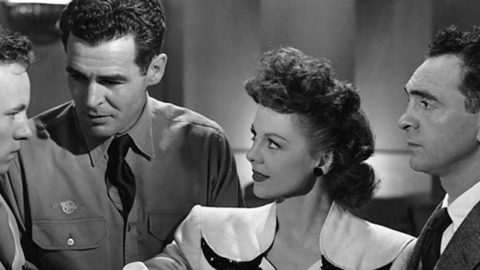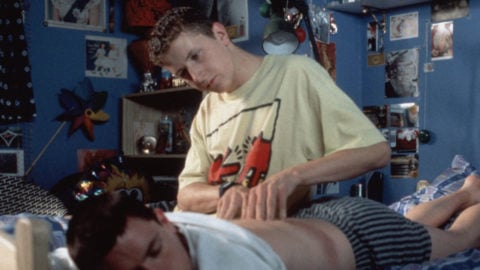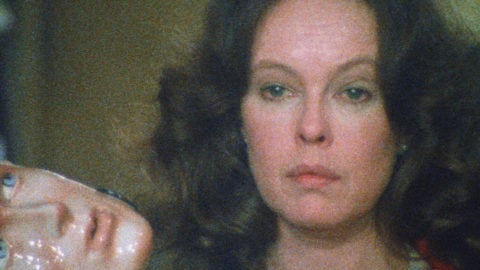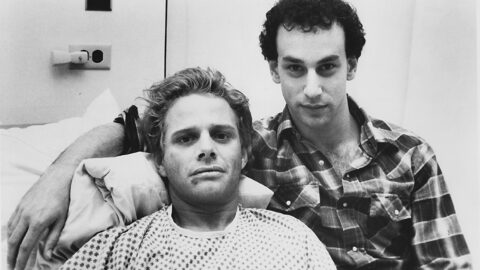Queer & Now & Then: 1953
In this biweekly column, I look back through a century of cinema for traces of queerness, whether in plain sight or under the surface. Read the introductory essay.
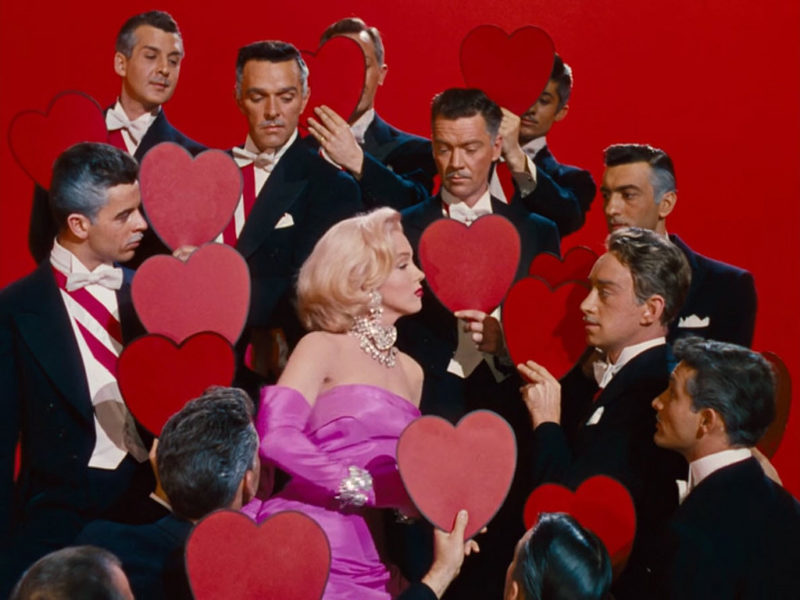
What makes a movie queer? The elasticity of the term can be daunting for the uninitiated, and even sometimes for the scholar. It’s a word that’s at once emotional and academic; it can either get at the core of a film’s purpose or speak to its unspoken, barely traceable outer edges. Queerness can be deeply embedded in the fabric of a film or completely extra-textual (every Judy Garland film, for example, is generally accepted as in some way queer due to her persona and the cult fan base that grew up around the actress). Queerness can be based on a feeling or come from years of entrenched study. There are films accepted in scholarly circles as essential queer texts that most other viewers would watch and largely see as quintessential examples of heterosexual reification—even good, upstanding, politically attuned, lavender-lensed viewers such as myself occasionally have to take a few extra bites to get to the chewy queer center of the lollipop. Case in point: Howard Hawks’s Gentlemen Prefer Blondes, regularly put on the list of stealth queer Hollywood classics—alongside Laura, Red River, Johnny Guitar, and a select group of others—despite the fact that the film guides its apparently man-hungry female protagonists through a series of traditional screwball shenanigans on its way to what seems to be a hetero wedding finale.
Yet Hawks was anything but a staunch literalist; his filmmaking was marked by a deep and rich thematic ambivalence toward gender and social constructs. Robin Wood famously noted in his films a “continually present, half-suppressed, sexual ambiguity in both male and female roles.” The tendencies in Hawks’s films for men and women to embody one another’s characteristics, and also for men and women to, respectively, prefer one another’s company, creates a homosocial order that occasionally takes on sexual overtones. Wood claims this finds its natural end in a latent thematic bisexuality, almost legible in such films as Bringing Up Baby, Only Angels Have Wings, Red River, Monkey Business, and Rio Bravo. This might all be theoretical, but it’s not implausible. The central Hawksian ironies of 1953’s Gentlemen Prefer Blondes, the most colorful musical spectacle of his career, stem from the filmmaker’s insouciant approach to social role-playing. While Hollywood films of the 1950s tended to place their heavily coded inquiries into sexuality within domestic spaces (Rebel Without a Cause, Tea and Sympathy, Written on the Wind), Gentlemen Prefer Blondes continues Hawks’s interrogation of sex and power within professional spheres. The matrimonial pursuits of its twinned female protagonists are inextricably tied to their careerism, making love itself often seem more like a matter of pragmatism than romance.
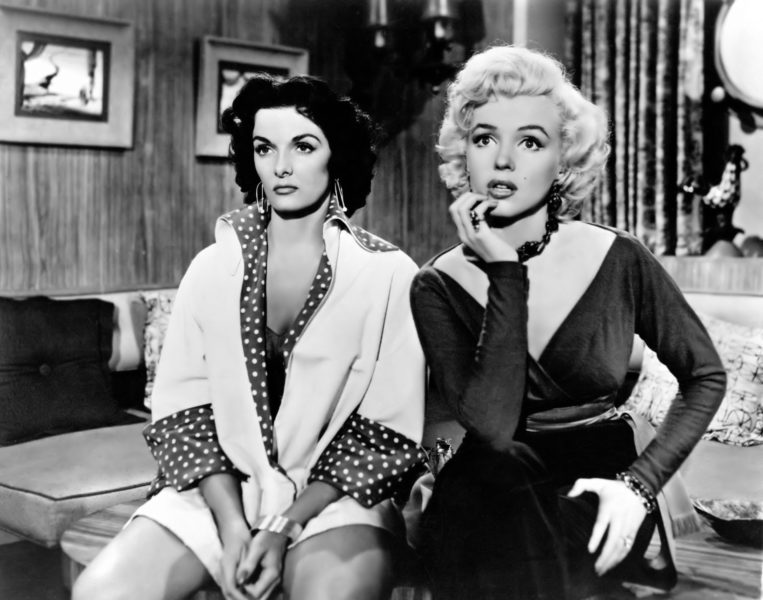
Heavily altered from a 1949 Broadway musical of the same name that was in turn adapted from a hit 1925 novel by Anita Loos (incidentally, a major screenwriting force in early Hollywood, hired by D.W. Griffith as a staff writer at Triangle Film Corporation), Gentlemen Prefer Blondes introduces joined-at-the-hip showgirls Lorelei and Dorothy (Marilyn Monroe and Jane Russell) in perhaps the greatest opening burst of red in film history. Without even the warning of opening credits, the women emerge with titanic force from behind shiny black and purple curtains in feathered head-dresses and form-fitting, sequined scarlet gowns, slit nearly up to the waist. As their song tells us, these bold women were once “Two Little Girls from Little Rock,” united together by both long-term friendship and the fact that neither has landed a husband. The lyrics would seem to situate the women as unrepentant gold-diggers (“Find a gentleman who is shy or bold / Or short or tall, or young or old / As long as the guy’s a millionaire!”), though this is pushed clearly to a satirical extreme. By putting these two women on the stage side-by-side, front and center, Hawks effectively neutralizes the tenor of the song (that Lorelei and Dorothy are on the prowl for men) by foregrounding their powerful female camaraderie. As the film will go on to suggest, Lorelei and Dorothy really only have eyes for each other.
Gentlemen may prefer blondes, but the film seems far more interested in what this blonde and brunette prefer. Onboard a ship en route to Cherbourg, France, where Lorelei plans to wed geeky but loaded American guy Gus (Tommy Noonan), the two women flirt, toy with, and evade a succession of men, who vary from a buzzed-about “eligible” bachelor who turns out to be a 7-year-old to a 75-year-old diamond-mine owner nicknamed Piggy (Charles Coburn). Also sharing space on the boat is the entire men’s Olympics team; they’re nonchalantly pursued by Dorothy, although she doesn’t get much flirtation in return from the athletically committed men—and more on that in a moment. None of these male characters, who run the gamut in terms of age and desirability, are paragons of romance, leaving our heroines to form no real bonds apart from the one between them. Even the film’s most famous number, Monroe’s “Diamonds Are a Girl’s Best Friend,” ultimately serves to distance Lorelei from men rather than endear her to them, reiterating the fact that her true attraction is purely nonsexual, and that love between a man and a woman is transactional. (One can imagine this is just one reason why none other than Rainer Werner Fassbinder was so enamored of Gentlemen Prefer Blondes, placing it on his list of the 10 greatest films of all time.)
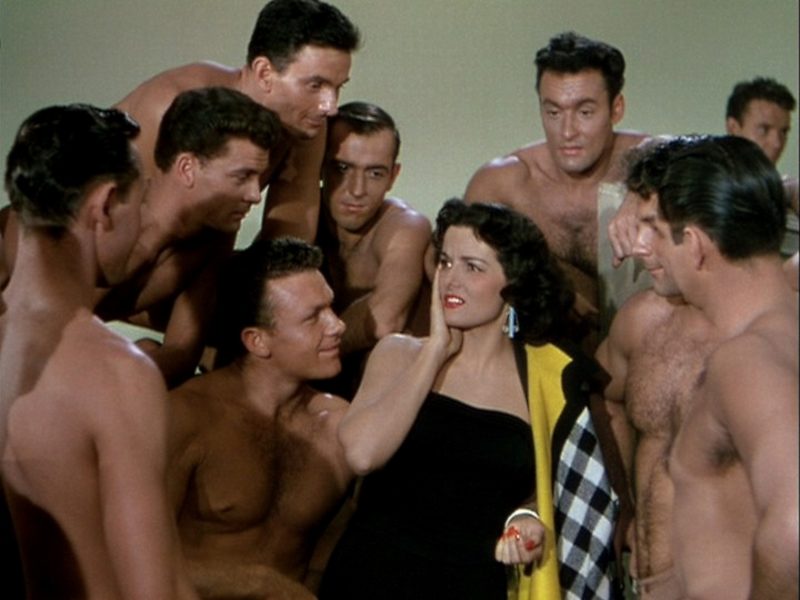
For many, the crux of the film’s queerness—and its most blatantly “gay” scene—concerns Dorothy and those wannabe Olympians. Though the number stands out starkly from the rest of the film’s narrative, Russell’s “Ain’t There Anyone Here for Love?”, written for the screen adaptation by Hoagy Carmichael, speaks eloquently to the essential disconnect between men and women at the heart of Hawks’s film. Not long after boarding the ship, Dorothy intrudes upon the men’s exercise routine, haplessly trying to get noticed by the gaggle of gorgeous, muscular athletes, all stripped to tiny, flesh-colored briefs as they flex, stretch, lift, and generally swan about the ship’s gym and pool. It’s a 1950s physique pictorial magazine come to life, and if there’s anything that doesn’t belong in one of those, it’s a woman. (Gentlemen prefer to be left alone?) These gender-flipped bathing beauties ignore her as she sings the title question again and again; at one point, as she brandishes two tennis rackets, they turn their asses to her in a rude parody of a kick-line; and, in the final insult, the men dive right over her head into the water.
The central joke of the scene is that busty Russell, who had been a major American sex symbol since her breakthrough in Howard Hughes’s sultry 1943 western The Outlaw (which Hawks had worked on as uncredited co-director), would be ignored by a room full of virile all-American males, all of whom would rather keep their eyes on the prize. While the choreography and composition of many Golden Age Hollywood musical numbers are identified by a certain mechanical quality that can be read as decidedly asexual (for example, the physical formations of women’s bodies in Busby Berkeley’s films of the 1930s, or the “clowning” scenes between men and women in Summer Stock and On the Town), “Ain’t There Anyone Here for Love?” is unique in the way it homoeroticizes while simultaneously defusing hetero chemistry at every turn.
Dorothy doesn’t fare well with these boys, but, following some circuitous plot contrivances, she’s ultimately happy to settle for blandly handsome Ernie Malone (Elliott Reid), a mysterious shipmate who turns out to be a private detective hired by Gus’s suspicious father to spy on Lorelei during the transatlantic voyage. Our two little girls from Little Rock end up marrying bewitched Ernie and bespectacled Gus, and as the film devises for no practical reason, the women tie their respective knots on the same day in the same church aisle. At the end, the brides arrive at the church in identical white gowns, walking in unison to the altar. As they approach their grooms, sly, bemused expressions on their faces imply that that they finally got what they wanted. Yet in the last image, the camera tracks in on the women, completely cropping the men out of the frame. Lorelei and Dorothy glance lovingly at each other rather than the off-screen husbands, and the picture fades to the closing card. Of this ending, queer studies scholar Alexander Doty wrote, “Rarely has a mainstream American film offered a finale so open to, and affirming of, bisexual erotics. But this final sequence only puts the capper on what has been a narrative filled with bisexual joie de vivre.” Movies are what you see, or perhaps what you want to see, and queer film readings have always depended on such wishful viewing. As an image of potential same-sex coupling, the end of Gentlemen Prefer Blondes is highly symbolic, but once that symbol has revealed itself to you, it’s also impossible to un-see. And who’d want to? Within the vernacular of coded Hollywood filmmaking, it’s a true marriage of equals.
Michael Koresky is the Director of Editorial and Creative Strategy at Film Society of Lincoln Center; the co-founder and co-editor of Reverse Shot; a frequent contributor to the Criterion Collection; and the author of the book Terence Davies, published by University of Illinois Press.



